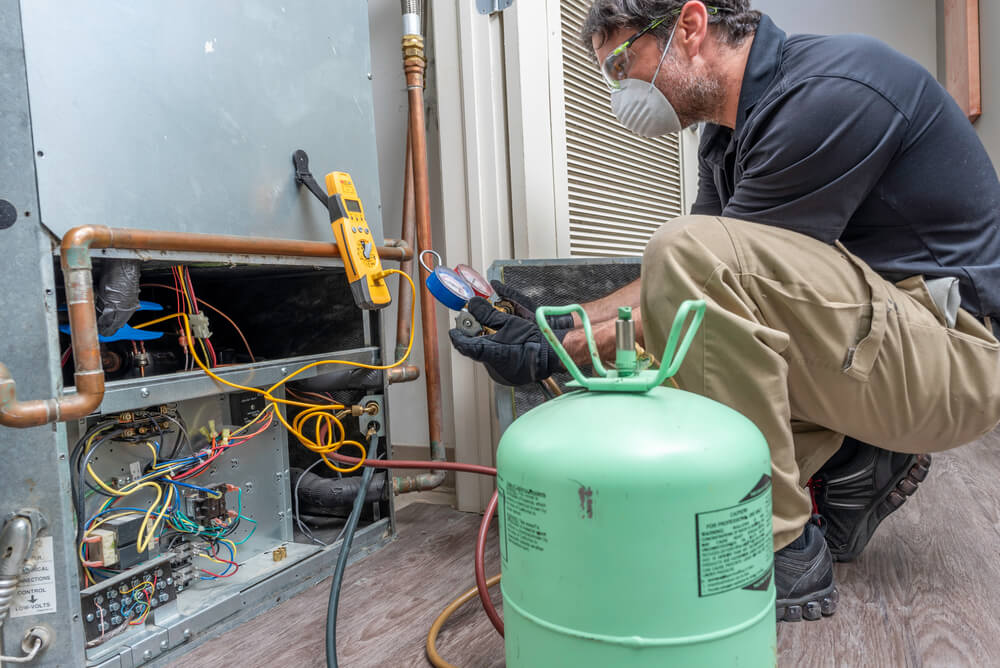
Coronavirus Update: We care about your health and continue to service our customers safely. Read More
Let us give you a wide spread out about R22 and R410A refrigerant respectively. Read along!
R22 refrigerant is one specific type of refrigerant, which is the main chemical your HVAC system uses to cool your home. Speaking all kinds of refrigerants run through your air conditioner or heat pump, and they constantly absorb and release heat to cool your home.
R22 refrigerant is no longer manufactured or imported into the United States, but it is still present inside some more aged HVAC units. If your AC unit uses R22 refrigerant and runs out, HVAC technicians may still have admission to the existing recycled or retrieved R22 supply and can repair your unit as normal. When you need to substitute the unit altogether, it gets really tough to place another R22-fixed system. Rather than that your new unit will use a more environmentally-friendly R22 refrigerant replacement, such as R410A refrigerant.

R410A refrigerant, also known as Puron, is a refrigerant that was developed by a company that is now known as Honeywell today. Even though this refrigerant still donates to global warming, it doesn’t deplete the Ozone layer. This newer refrigerant is highly recommended as it can help you conserve money on energy and electricity bills each month. The refrigerant doesn’t drive the compressor to overheat as much, which means that it runs on less power than an air conditioning unit with R22. R410A Refrigerant also operates at a greater pressure, so newer units consistent with this refrigerant can fight stress and reduce the odds of cracking.
Whereas air conditioners with R22 refrigerant use mineral oil for lubrication, models that use R410A Refrigerant use synthetic oil. Synthetic oil is more soluble with its R410A air conditioner than mineral oil is with an R22 air conditioner. This means that there is less wear and wear that goes on in newer air conditioners, meaning that they can last extended and encounter problems much less frequently. Air conditioners are required to possess oil in certain amounts to stay lubricated when they are operating. R410A refrigerant has been approved for use in new residential air conditioners and is a hydro-fluorocarbon (HFC) that does not donate to ozone depletion.
Newer air conditioning models are manufactured to be utilized with R-410A refrigerant for dedicated and more capable operation.
Reduced Heat Generation: Because R-410A can enthrall and excrete more heat than R-22, your air conditioning compressor can operate cooler, lowering the hazard of compressor burnout due to overheating.
High Pressure Performance: R-410A also operates at a higher pressure than R-22, so new compressors are built to resist greater stresses, decreasing the chance of cracking. If you were to put R-410A refrigerant into a system designed for R-22, the pressure would be too high and the unit would break.
Ability to Decrease Stress: Generally, air conditioners consume oil to hold the compressor to its best efficiency during operation. R-22 air conditioners use mineral oil and R-410A systems use synthetic oil. With R-410A, synthetic oil ought to be more soluble than mineral oil with R22. This just goes to prove the R-410A refrigerant works more seamlessly towards decreasing stress on the compressor.
While R22 refrigerant was outlawed in 2010 for incorporation in new AC units, some companies are leveraging advantage of the law by producing what’s known as ‘dry charge’ units. These are new units that don’t have the refrigerant fixed at the factory. To be honest, you will easily be able to find a professional to reach out to your home and fix the R22 refrigerant, but although this procedure is technically lawful, this isn’t the best choice considering the below reasons- There is a limited supply of R-22 and its price will increase as supplies diminish. Well, R410A renders greater efficiency, saving you in energy costs, and is much better for the environment. Also, Dry charged units typically offer much shorter warranty periods.
We firmly believe that the above mentioned information would suffice you with everything that you should comprehend about R22 and R410A refrigerant and also justification for why you should shift from R22 refrigerant to R410A refrigerant.